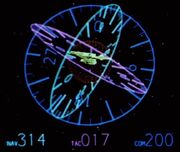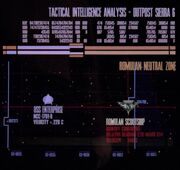Archer4real (talk | contribs) No edit summary |
Lakenheath72 (talk | contribs) mNo edit summary Tag: sourceedit |
||
| (29 intermediate revisions by 6 users not shown) | |||
| Line 1: | Line 1: | ||
| + | [[File:Hnd.jpg|thumb|360-degree axes]] |
||
| − | '''Bearing''' is a description of the position of a [[spaceship|space vessel]] in relation to another object, such as a [[planet]], [[star]], [[starbase]] or other object in relation to the forward direction of travel and is usually accompanied by a distance measurement. An object on a bearing of 090 mark 270 is directly below the vessel; an object bearing 300 mark 10 is located to the port side of the vessel and above the current plane of travel. |
||
| + | [[File:Tactical analysis sierra vi.jpg|thumb|[[Romulan scoutship]] at relative bearing 270/mark 014]] |
||
| + | A '''bearing''', sometimes referred to as '''relative bearing''', was a common way to describe a specific direction in relation to a [[starship]]. ({{TOS|Balance of Terror}}; {{TNG|The Defector}} ''display graphic'') |
||
| + | == Uses == |
||
| − | '''Bearing''' differs from '''[[heading]]''' in that '''bearing''' refers to the position of an object relative to the position of the vessel taking the bearing, while heading describes the direction of travel. |
||
| + | Bearings were commonly used to define the direction at which another object or the origin of a transmission was located in [[space]], in relation to the current orientation of the ship. Bearings have also been used to indicate a direction on a [[planet]] by an [[away team]] on the surface or from the planet's [[atmosphere]]. Bearings were also used when the ship made a course correction in its current [[heading]]. ({{TOS|Balance of Terror|By Any Other Name}}; {{film|4}}) |
||
| + | In space, bearings were given in one or two 360-degree angles, sometimes with one or two decimal place accuracy, with various other information. For example: |
||
| − | In [[2355]] [[Captain]] [[Jean-Luc Picard]] of the [[USS Stargazer]] ordered a sensor ''bearing'' of a hostile (later identified as [[Ferengi]]) ship, and was advised the bearing was seven-mark-nineteen (7-19), putting the vessel slightly above and to starboard of the {{USS|Stargazer}}. He then ordered his [[helmsman]] to engage warp nine on a ''heading'' of seven-seven-mark-twenty (77-20), traveling further starboard, and up on the vertical plane. ({{TNG|The Battle}}) |
||
| + | * "''05-mark-231.''" ({{TNG|The Emissary}}) |
||
| + | * "''0-mark-4.''" ({{VOY|Once Upon a Time}}) |
||
| + | * "''111-mark-14''" ({{TOS|Balance of Terror}}) |
||
| + | * "''316-mark-4''" ({{film|2}}) |
||
| + | * "''Mark-73-point-5.''" ({{TOS|Elaan of Troyius}}) |
||
| + | * "''23-mark-217. Range 31 hundred [[kilometer]]s.''" ({{DS9|Emissary}}) |
||
| + | * "''001-mark-point-03. Range 300 thousand kilometers.''" ({{TNG|Sins of the Father}}) |
||
| + | * "''320 degrees-mark-2.''" ({{film|11}}) |
||
| + | * "''240 degrees-mark-6, [[port]].''" ({{film|6}}) |
||
| + | * "''123 degrees-mark-18. Range 90 thousand kilometers.''" ({{TOS|The Changeling}}) |
||
| + | On a planet, bearings were also given in one or two 360-degree angles, with various other information. For example: |
||
| − | Some bearings (or headings) can be expressed using one of two different measurements. An object directly behind (or turning completely around) could be expressed either as one-eight-zero-mark-zero (180-0) or zero-mark-one-eight-zero (0-180). |
||
| + | * "''300-mark-7.''" ({{TOS|By Any Other Name}}) |
||
| + | * "''94-mark-7, angle of elevation 6 degrees.''" ({{TOS|Obsession}}) |
||
| + | * "''About 11 [[mile]]s, bearing 121 from the mining company.''" ({{TOS|Mudd's Women}}) |
||
| + | * "''283 degrees. 15.2 kilometers.''" ({{film|4}}) |
||
| + | * "''327 degrees. Distance 600 [[nautical mile|nautical]].''" ({{film|4}}) |
||
| + | == Appendices == |
||
| + | === See also === |
||
| + | * [[Coordinates]] |
||
| + | * [[Borg spatial designations|Grid]] |
||
| + | * [[Heading]] |
||
| + | * [[Navigation]] |
||
| + | * [[Quadrant]] |
||
| + | * [[Sector]] |
||
| + | === Background information === |
||
| − | {{stub}} |
||
| + | The first use of the term bearing to indicate a direction occurred in ''[[Star Trek: The Original Series]]'' episode "Balance of Terror". The meaning of bearings has been further defined in the writer's guides and several [[reference books]], such as ''[[Star Trek: The Next Generation Technical Manual]]'' (pg. 36). Bearing 000-mark-0 is directly in front of the ship and bearing 180-mark-0 directly behind the ship. Coming about to bearing 090-mark-0 would be a sharp turn to the right or [[starboard]]. Coming about to bearing 270-mark-0 would be a sharp turn to the left or port. The second figure after the "mark" is the elevation angle. Coming about to bearing 000-mark-90 would be tilting the ship directly upwards and 000-mark-270 directly downwards. |
||
| − | == |
+ | === Deleted references === |
| + | According to the {{st-minutiae|academy/literature329/twok.txt|script}} for {{film|2}}, a second patrol formation of [[Klingon]] [[cruiser]]s approached the {{USS|Enterprise|NCC-1701}} on a bearing of "''090-mark-20''" to the {{USS|Enterprise|NCC-1701}} in the ''[[Kobayashi Maru]]'' [[Kobayashi Maru scenario|scenario]]. |
||
| + | |||
| + | According to the {{st-minutiae|academy/literature329/tvh.txt|script}} for {{film|4}}, as the {{HMS|Bounty}} was leaving [[Earth]], [[Nyota Uhura|Uhura]] detected an unidentified [[aircraft]] in Earth's [[atmosphere]] at "''range 30 miles, bearing 010''". |
||
| + | |||
| + | === External link === |
||
* {{wikipedia|Bearing (navigation)}} |
* {{wikipedia|Bearing (navigation)}} |
||
| + | [[Category:Cartography]] |
||
Revision as of 18:16, 19 March 2015

360-degree axes

Romulan scoutship at relative bearing 270/mark 014
A bearing, sometimes referred to as relative bearing, was a common way to describe a specific direction in relation to a starship. (TOS: "Balance of Terror"; TNG: "The Defector" display graphic)
Uses
Bearings were commonly used to define the direction at which another object or the origin of a transmission was located in space, in relation to the current orientation of the ship. Bearings have also been used to indicate a direction on a planet by an away team on the surface or from the planet's atmosphere. Bearings were also used when the ship made a course correction in its current heading. (TOS: "Balance of Terror", "By Any Other Name"; Star Trek IV: The Voyage Home)
In space, bearings were given in one or two 360-degree angles, sometimes with one or two decimal place accuracy, with various other information. For example:
- "05-mark-231." (TNG: "The Emissary")
- "0-mark-4." (VOY: "Once Upon a Time")
- "111-mark-14" (TOS: "Balance of Terror")
- "316-mark-4" (Star Trek II: The Wrath of Khan)
- "Mark-73-point-5." (TOS: "Elaan of Troyius")
- "23-mark-217. Range 31 hundred kilometers." (DS9: "Emissary")
- "001-mark-point-03. Range 300 thousand kilometers." (TNG: "Sins of the Father")
- "320 degrees-mark-2." (Star Trek)
- "240 degrees-mark-6, port." (Star Trek VI: The Undiscovered Country)
- "123 degrees-mark-18. Range 90 thousand kilometers." (TOS: "The Changeling")
On a planet, bearings were also given in one or two 360-degree angles, with various other information. For example:
- "300-mark-7." (TOS: "By Any Other Name")
- "94-mark-7, angle of elevation 6 degrees." (TOS: "Obsession")
- "About 11 miles, bearing 121 from the mining company." (TOS: "Mudd's Women")
- "283 degrees. 15.2 kilometers." (Star Trek IV: The Voyage Home)
- "327 degrees. Distance 600 nautical." (Star Trek IV: The Voyage Home)
Appendices
See also
Background information
The first use of the term bearing to indicate a direction occurred in Star Trek: The Original Series episode "Balance of Terror". The meaning of bearings has been further defined in the writer's guides and several reference books, such as Star Trek: The Next Generation Technical Manual (pg. 36). Bearing 000-mark-0 is directly in front of the ship and bearing 180-mark-0 directly behind the ship. Coming about to bearing 090-mark-0 would be a sharp turn to the right or starboard. Coming about to bearing 270-mark-0 would be a sharp turn to the left or port. The second figure after the "mark" is the elevation angle. Coming about to bearing 000-mark-90 would be tilting the ship directly upwards and 000-mark-270 directly downwards.
Deleted references
According to the script for Star Trek II: The Wrath of Khan, a second patrol formation of Klingon cruisers approached the USS Enterprise on a bearing of "090-mark-20" to the USS Enterprise in the Kobayashi Maru scenario.
According to the script for Star Trek IV: The Voyage Home, as the HMS Bounty was leaving Earth, Uhura detected an unidentified aircraft in Earth's atmosphere at "range 30 miles, bearing 010".
